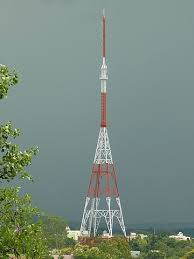Welcome to the March issue of Blog Logs. Thank you for your emails and logs, and for following the Shortwave Central blog and X/Twitter at: Shortwave Central @QSLRptMT.
Have you subscribed to the Shortwave Central YouTube channel? You will find a vast selection of videos and audio airchecks. The Playlist is growing! Join your fellow radio enthusiasts at:
https://www.youtube.com/c/ShortwaveCentral
Shortwave Central brings you the latest from the ever-changing realm of radio. Additional radio information is covered in my Bits & Bytes monthly column in The Spectrum Monitor e-zine at:
https://www.thespectrummonitor.com/
Languages as indicated
// denotes station heard on a parallel frequency
*Sign-on Sign-Off*/ frequencies in kHz
Monitoring February 1-27, 2025
All times UTC
Mediumwave
Argentina
840, Radio Nacional, Paso de los Libres 0319. Spanish text to Argentine style music. ID, “Radio Nacional,” SINPO 25442 (Rudolf Grimm, São Bernardo, SP, Brazil).
Brazil (Portuguese)
620, Rádio Jandaia do Sul, PR at 2350. Station ID, “a melhor música está aqui, na Jandaia…programa Painel de Secessos….” Station announcements, SINPO 35433 (Grimm, Brazil).
650, Rádio Difusora, Piracicaba SP at 2310. Discussion about sports, Palmeiras, Corinthians.’ SINPO 35543 (Grimm, Brazil).
Egypt
864, NMA Al-Quran al-Karim, Santah. Arabic at 0141. Quran text,SINPO 25432. Previously, this frequency was heard in São Bernardo as Egyptian Radio in 2001. In 2020, ERTU Al-Quran al-Karim, and now in 2025 as NMA Al-Quran al-Karim (Grimm, Brazil).
Spain
855, Radio Nacional de Espa?a. Spanish talk to interview with a station reporter speaking about Spain. SINPO 25422 (Grimm, Brazil).
Shortwave
Ascension Island
21630, BBC WS relay via Georgetown. Hausa service at 1418. A male announcer’s text to an African style-music. SINPO 35553 (Grimm, Brazil). 9410 at 0502 with English news for good signal (Harold Sellers, BC Canada).
Botswana
6080, Voice of America relay at 0333. English news, including plane crash coverage at Toronto’s airport. Fair signal // 4930 very poor, 9775 good (Sellers, Canada). 9775 VOA Botswana relay at 0405-0430. News magazine style program on Africa (Gayle Van Horn, LA Kiwi SDR)
Brazil (Portuguese)
6010, Rádio Inconfidencia, Belo Horizonte, 2114-2136. Brazilian vocals and comments to station identification. // 15189.8; Also 0604-0655. (Manuel Méndez, Spain/BDXC)
6150, Rádio Saturno, Belo Horizonte 2107-2118. Brazilian songs to ID and comments “Rádio Saturno a sua melhor companhia.” SINPO 15422 (Méndez).
6180, Rádio Nacional da Amazonia, Brasilia 2102-2118. Soccer commentary to station identification // 11780, SINPO 25422. Also heard 0831-0847 with Brazilian songs. SINPO 25422 (Méndez).
9818.6, Rádio 9 de Julho, São Paulo 2046-2108. Religious music and comments. SINPO 25422 (Méndez)
11750, Voz Missionaria, Camboriú 2002-2034. Religious music and comments. Also heard 0607-0655 with same format (Méndez).
11815, Rádio Brasil Central at 1630. Signal distorted with little to understand. Strong spurious signal at 11960 kHz (Grimm, Brazil).
15190 Rádio Inconfidencia, Belo Horizonte 1629-1708. Brazilian music and program “Brasileirissima.” SINPO 15422 (Méndez).
Canada
 |
| CFRX QSL |
6070, CFRX Toronto 0817-0833. English comments to newscast. Strong interference from Germany’s Channel 292 on the same frequency (Méndez).
China
4800, China National Radio 1-Voice of China at 0037-0100. Chinese/Mandarin text and talking. Barely audible reception with poor signal at times. SINPO 25411-25422 . Additional monitoring: 15160, China Radio International 0136-0146. Chinese/Mandarin with lady talking over background music. Poor reception SINPO 25522 (Ronaldo Xavier, Cabedelo, PB, Brazil/HCDX).
Clandestine
6155, Furusato no Kaze at 1700. Japanese programming with typical sign-on. Text on the plight of Japanese held in North Korea. Upbeat song from male chorus. Good signal, but noisy (Tony Pavick, BC Canada/NASWA Flashsheet).
11650, Radio Tamazuj at 0345. Noted as Arabic (Juba) service with text and Arabic style instrumental (Frank Hillton, SC).
14980, Sound of Hope via Miaoli. Chinese service at 1250. Talk from male announcer to music. Strong interference from China’s CNR1. SINPO 12431 (Grimm, Brazil).
Cuba
5025, Radio Rebelde in Spanish at 0412. Male/female conversation with good signal quality (Sellers, Canada). 5025 Radio Rebelde at 1230. Fair signal in Spanish with weak signal music and text (Van Horn, LA Kiwi SDR)
Ecuador
 |
| HCJB QSL |
6050, HCJB, Pinchincha, 0418-0427. Spanish religious format with music and text. SINPO 35433 (Hillton, SC). Additional logging: 6050, 0050-0110 with same format. Fair-poor signal quality. Additional monitoring 6050 in Quechua from 0200-0235*. Included vocals from singer Alex Rodriguez. Fair signal quality SINPO 34333. (Van Horn, LA Kiwi SDR)
Guam
15400, KTWR, Merizo. English service at 1248. Christian broadcast and text. Interval signal at 1259. “KTWR” ID and contact address. Programming targets South Asia. Guam, 15530, AWR Agat, Guam at 1302. Religious text and vocal. SINPO 25442 (Grimm, Brazil).
India
15260, Akashvani/All India Radio via Bengaluru in Indonesian. Indian music, station ID and additional music. Fair reception SINPO 35533 (Xavier, Brazil)
Japan
 |
| Nikkei QSL |
6055, Radio Nikkei 1, Chiba. Japanese at 0837. English pop songs to announcer’s commentary. Instrumental music, programming targets Japan and Far East. 6115, Radio Nikkei 2 in Japanese. At 0902 (Grimm, Brazil). NHK Radio Japan on 17810 at 0443. Japanese service and announcer’s chats for good signal (Sellers, Canada).
17810, NHK Radio Japan at 0200. Japanese service with Japanese pop vocals and station ID (Sam Wright, MS)
Kuwait
11850, Voice of America relay at 0338. Kinyawanda service includes text and prerecorded events. Good signal (Sellers, Canada). Radio Free Europe/Radio Liberty 12140 at 0419. Pashto service with lady’s text and intro to Dari service. Fair signal quality (Sellers, Canada).
Liberia
6050, ELWA Radio, Monrovia *0555-0628. Interval signal to English station ID. Religious comments and vocals.SINPO 25422. Also heard *0558-0645 with English comments and text (Méndez).
Madagascar
13760, African Pathways Radio at 0327. English programming with praise music into religious text. Fair signal but deteriorating as co-channel Voice of Korea’s Spanish service dominates (Sellers, Canada).
11735, Voice of America relay at 1735. Listed as Shona service with text and VOA identifications (Van Horn, LA Kiwi SDR)
Mali
5995, ORTM/Radio Mali, Bamako. 1800-1845. Station ID to French news format. African music as pop and local indigenous. Mali on 9635 1755-1800.* Africa music and IDs (Van Horn, LA Kiwi SDR)
North Korea
 |
| VOK QSL |
15180, Voice of Korea in English at 0438. Orchestral music to the lady’s vocals. Poor signal // 11735 (Sellers, Canada). 12015 VO Korea at 1943-1955 in Spanish. Station IDs, choirs to orchestral music (Xavier, Brazil).
Oman
15295, BBC WS relay via Al-Seela in English at 1255. Political discussion from male/female announcers to music. SINPO 35443 to South Asia (Grimm, Brazil).
Peru
4809, Radio Logos, Chazuta at 0905. Monologue by male in presumed Quechua to flute interludes. Station’s local time check in Spanish, then back to rustic vocals. Canned ID at 0923, followed by vocals from Banda Apocalpsis and another “Radio Logos” identification. Excellent modulation and nice signal despite thunderstorm crashes (Brandon Jordan, TN/NASWA Flashsheet)
Philippines
15120, USAGM/Radio Free Asia via Tinang. Burmese service at 1248. Male/female commentary, targeting Myanmar. SINPO 35543 (Grimm, Brazil). Philippines-Radyo Pilipinas via Tinang on 17820 at 0243-0255. Station IDs and talk about the Philippines. Fair reception SINPO 35533 (Xavier, Brazil).
Spain
9690, Radio Exterior Espana 0200-0215. Spniah program after time pips and ID. “La Cresta de la Onda” with variety news, sports updates for good reception. SINPO 45544 (Xavier, Brazil).
United Arab Emirates
11875, Voice of America relay at 0341. Somali service with talk about Somalia frequently. VOA singing promo // 9510 via Vatican relay very good; 9825 Germany relay was fair (Sellers, Canada).
United States
6075, KNLS New Life Station-Anchor Point, Alaska. 0855. Contemporary Christian music to the announcer’s talk. SINPO 25332, 0859*. (Grimm, Brazil).
 |
| WTWW QSL |
9930, WTWW Lebanon at 2340. Christian broadcast to religious message. Frequent applause before the presumed live event. Interview and phone-in calls. SINPO 25442, programming targeted to North America (Grimm, Brazil).
Uzbekistan
15135, BBC WS relay via Tashkent. Korean program at 1255. Male/female commentary to 1259*. SINPO 25542 targeting North/South Korea (Grimm, Brazil)
7470, IBRA Media/Radio Ibrahim at 1500. Listed as Bengali service for talks and Asia music vocals for fair-poor signal quality (Hillton, SC)




.JPG)









.jpg)
















